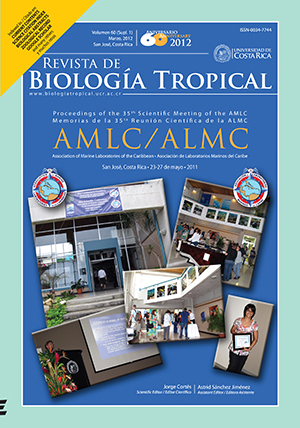Abstract
The progressive downward shift in dominance of key reef building corals, coupled with dramatic increases in macroalgae and other nuisance species, fields of unstable coral rubble ,loss of structural relief, and declines of major functional groups of fishes is a common occurrence throughout the Caribbean today. The incorporation of resilience principles into management is a proposed strategy to reverse this trend and ensure proper functioning of coral reefs under predicted scenarios of climate change, yet ecosystem processes and functions that underlie reef resilience are not fully understood. Rapid assessments using the Atlantic and Gulf Rapid Reef Assessment (AGRRA) and the IUCN Resilience Assessment protocol can provide baseline information on reef resilience. A key aspect of these surveys focuses on coral population dynamics, including measures of coral cover, size, partial and whole-colony mortality, condition, and recruitment. One challenge is that these represent static measures involving a single assessment. Without following individual corals over time, it is difficult to determine rates of survival and growth of recruits and adult colonies, and differentiation of juveniles from small remnants of older colonies may not be possible, especially when macroalgal cover is high. To address this limitation, corals assessed in Bonaire in July 2010 were subdivided into two categories: 1) colonies on the reef substrate; and 2) colonies colonizing dead corals and exposed skeletal surfaces of living corals. Coral populations in Bonaire exhibited many features indicative of high resilience, including high coral cover (often 30-50%), high levels of recruitment, and a large number of corals that settled on dead corals and survived to larger size-classes. Overall, the skeletal surfaces of 12 species of corals were colonized by 16 species of corals, with up to 12 settlers on each colony, most (67%) on M. annularis (complex) skeletons. Nevertheless, completely dead M. annularis colonies were common, survivors were frequently reduced in size and subdivided into smaller tissue remnants, and these species exhibited higher amounts of partial mortality than all other species. A notable absence of sexual recruits and juveniles of M. annularis illustrates a progressive shift away from a Montastraea dominated system. This shift, characterized by an increasing dominance of smaller, short-lived species such as Agaricia and Porites and a reduction in size of longer-lived massive corals, is occurring throughout the Caribbean. Monitoring of the survival of recruits is necessary to determine whether Caribbean reefs will retain the same function, structure, identity and feedbacks (key signs of resilience) if the losses of M. annularis (complex) continue at present levels. The rapid assessment protocol utilized here allows characterization of colony size structure, partial mortality, recruitment, and whether small corals represent surviving recruits that increased in size or larger (older) colonies that continue to shrink in size. This approach can help determine the history of a site and its resilience.##plugins.facebook.comentarios##
Downloads
Download data is not yet available.






